Mysteries of the Universe
(A Vega Vids Production)
Special 21st Century Blog Edition
The Peach of Immortality: Ancient Legend or Evidence of Time Travel???
Bobert Crandon: Good rotations and welcome to this very special edition of Mysteries of the Universe. We’re about to plunge into an incredible world of art, mythology and mystery with the help of two very special guest commentators: Prince Driscoll Garrett and Prince Cüinn Cleary. Prince Cüinn, why don’t you begin by telling us how this astounding journey into the unknown began?
Cüinn Cleary: It was some years ago, Bobert, when Tara and Hurley went to the Imperial Palace on Vuernaco to settle her late uncle’s affairs. While they were there, Hurley passed the time by examining the vast collection of Ancient Earth artifacts in the Hall of History.
Driscoll Garrett: It was of marginal interest to Hurley, but as an artist myself, I carefully reviewed the memories in his branch to expand my knowledge of Earth culture. It was only when the research done by Tara and Cüinn uncovered the true history of the Cu’endhari nau’gsh that I understood the significance of some of the objects in the museum. In a number of the relics from Ancient China, the theme of “peaches of immortality” kept reoccurring.
CC: Obviously, the connection between peaches and immortality struck a bell. So we decided to research it further. According to the Chinese legends, the Queen Mother of the West had an orchard of these trees, and she would allow the immortals to feast every six thousand years.
DG: Because of this, the peach is symbolic for long life in the art of Ancient China. Let’s look at an example from the Hall of History. Before we get started, a word about the illustrations. I was a little taken aback when I realized that I wouldn’t be able to use holographic images. But then I decided to roll with it and use something a propos to the medium. I was actually able to find and restore an authentic Nikon Coolpix circa 2013. Let me tell you, it was a challenge to use! I don’t know how the ancient web photographers managed, frankly. It was like the voyage of the Kon Tiki.
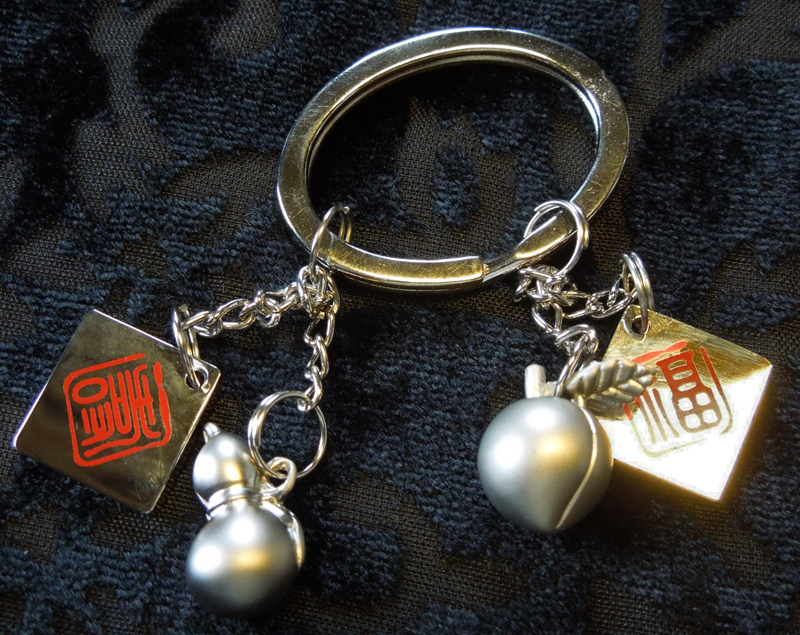 Anyway, this magnificent piece is a key chain, circa 2013. It depicts a peach and a gourd. The gourd supposedly contains the elixir of immortality.
Anyway, this magnificent piece is a key chain, circa 2013. It depicts a peach and a gourd. The gourd supposedly contains the elixir of immortality.
It’s difficult to believe, I know, but this exquisite item was actually mass-produced in a factory! I can hardly compass the idea that an entire factory was constructed to produce these objects d’art, and that they made thousands of them all at once, instead of simply programming a fabricator to make them on demand. I’m stunned at the grandiose designs of 21st century humanity. This is a magnificent piece: look at the cleanliness and precision of the lines. It’s awe-inspiring to think of the ingenuity that could achieve such perfection with the crude technology available.
CC: The peach of immortality was thus depicted in any context that indicated long life. For example, it would often be seen in tableaux depicting the Eight Immortals, or carried by Shou, the God of Long Life.
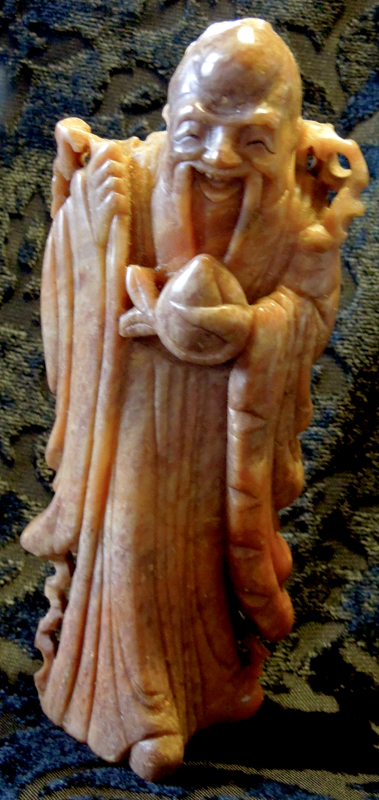 DG: This soapstone carving of Shou is a remarkable example of the mid 20th century faux-antiquities style. In my opinion, it’s superior even to Tara’s Hawaiian ceremonial dagger letter-opener.
DG: This soapstone carving of Shou is a remarkable example of the mid 20th century faux-antiquities style. In my opinion, it’s superior even to Tara’s Hawaiian ceremonial dagger letter-opener.
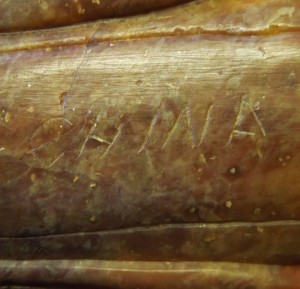 Examining the back, we note how brazenly the artist has carved the word “China” into the statue in English lettering – there isn’t even a pretense of authenticity. It’s this juxtaposition of the sacred and the commercial, the anachronistic clash of centuries, that makes the high irony of this style so delicious.
Examining the back, we note how brazenly the artist has carved the word “China” into the statue in English lettering – there isn’t even a pretense of authenticity. It’s this juxtaposition of the sacred and the commercial, the anachronistic clash of centuries, that makes the high irony of this style so delicious.
CC: According to some theories of Taoism, the reason that Shou is always smiling is that his source of long life is sexual energy. Now it really gets interesting because the peach is a symbol of that energy. In fact, peach blossoms were supposed to be useful to induce a trance of love.
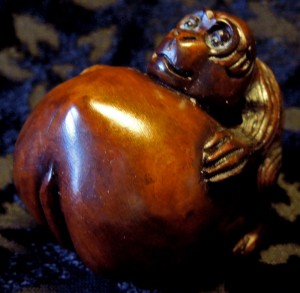 DG: The symbolism is pretty clear from this piece. This is actually of Japanese provenance, a netsuke depicting a monkey and a peach. The monkey is also connected to the idea of long life. The Queen Mother of the West was supposed to have a monkey as a pet, and it would fetch the peaches for her.
DG: The symbolism is pretty clear from this piece. This is actually of Japanese provenance, a netsuke depicting a monkey and a peach. The monkey is also connected to the idea of long life. The Queen Mother of the West was supposed to have a monkey as a pet, and it would fetch the peaches for her.
 DG: Quite often monkeys and peaches were depicted together. But I think this work of art leaves very little doubt as to what sort of monkeying around is happening.
DG: Quite often monkeys and peaches were depicted together. But I think this work of art leaves very little doubt as to what sort of monkeying around is happening.
CC: So far, we’ve only seen tantalizing hints at the truth. But now we’re going to look at something really amazing.
 DG: This is a ceramic water-dropper, used in calligraphy for mixing ink. It’s clearly in the form of a peach – note the telltale cleft. But the color of the glaze is wrong. No peach on Earth is that color.
DG: This is a ceramic water-dropper, used in calligraphy for mixing ink. It’s clearly in the form of a peach – note the telltale cleft. But the color of the glaze is wrong. No peach on Earth is that color.
CC: Suggestive, perhaps. But the skeptic in me said, Cüinn, maybe that was the only color glaze the artist had. Maybe s/he was just some kind of surrealist. But then, we found this.
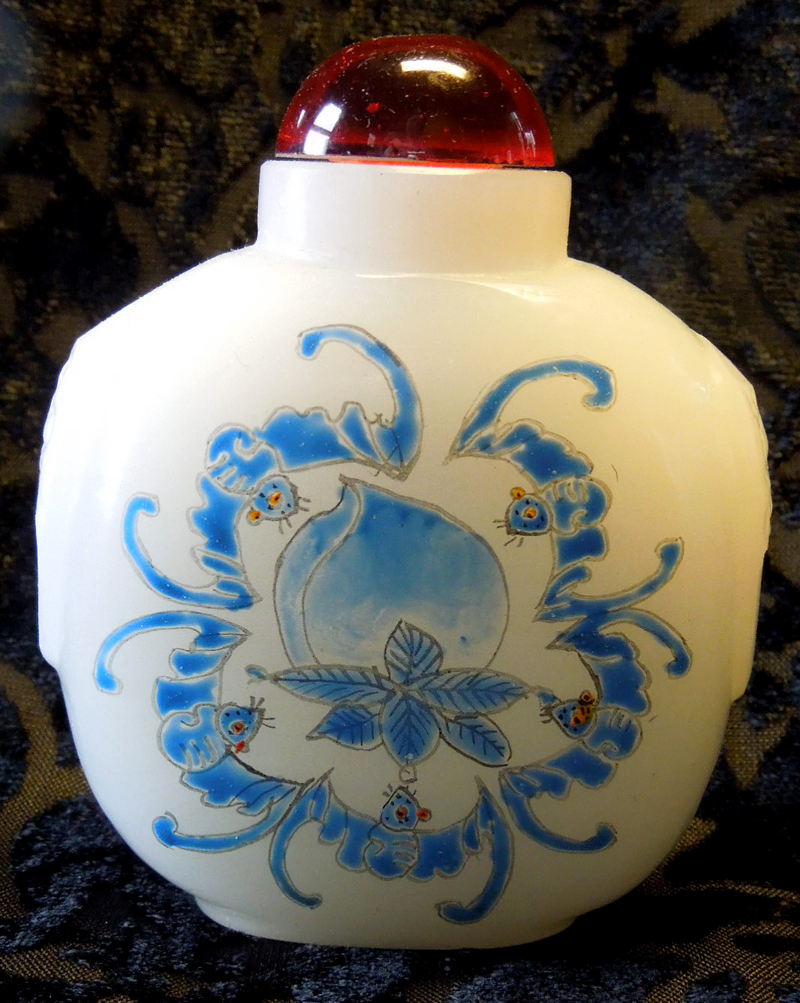 DG: Another common pairing in Ancient Chinese art is the peach and bat. Supposedly, the bat is a symbol of happiness. This is because the words for bat and happiness are homophones – or so they say. We found this snuff bottle depicting the combination of peach and bat. Look at the exquisite shading on the “peach.” It’s not a mistake.
DG: Another common pairing in Ancient Chinese art is the peach and bat. Supposedly, the bat is a symbol of happiness. This is because the words for bat and happiness are homophones – or so they say. We found this snuff bottle depicting the combination of peach and bat. Look at the exquisite shading on the “peach.” It’s not a mistake.
CC: That’s a nau’gsh if I ever saw one.
 DG: The “peach” is surrounded by an array of five “bats.” Compared to the lifelike depiction of the “peach,” the “bats” are quite abstracted. They have no feet, ribbed torsos, pointed skulls, and protrusions from the heads.
DG: The “peach” is surrounded by an array of five “bats.” Compared to the lifelike depiction of the “peach,” the “bats” are quite abstracted. They have no feet, ribbed torsos, pointed skulls, and protrusions from the heads.
CC: Antennae. Those aren’t bats, they’re moths.
DG: This last piece is the clincher. It’s a statue of a peach, with figures in relief upon it. The central figure is Shou again. But there are all these other figures.
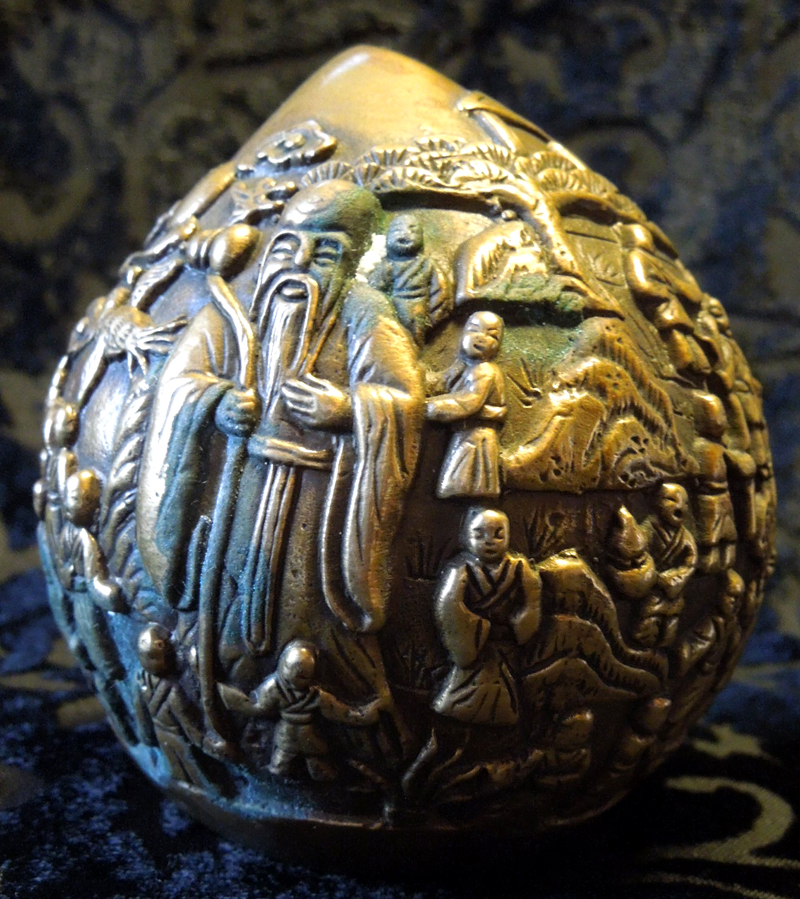 CC: There are two theories as to what these figures represent. Either they are monks which supposedly pray for the well-being of the owner of the statue, or they are “a hundred boys” – conveying the giver’s wish that the receiver should bear or father many sons.
CC: There are two theories as to what these figures represent. Either they are monks which supposedly pray for the well-being of the owner of the statue, or they are “a hundred boys” – conveying the giver’s wish that the receiver should bear or father many sons.
 DG: The only problem with this theory is that the figures neither look like praying monks nor young boys. They look like men at a variety of tasks. One is clearly climbing a ladder and another is holding what appears to be a tree in a pot.
DG: The only problem with this theory is that the figures neither look like praying monks nor young boys. They look like men at a variety of tasks. One is clearly climbing a ladder and another is holding what appears to be a tree in a pot.
CC: To those capable of recognizing it, the symbolism is clear. The carvings depict the pleroma of the Cu’enashti which produced the “peach,” that is the nau’gsh fruit. The men are the various emanations inside of the pleroma. Possibly the figure of Shou is a stand-in for the branch that produced the fruit, or maybe even the mothman.
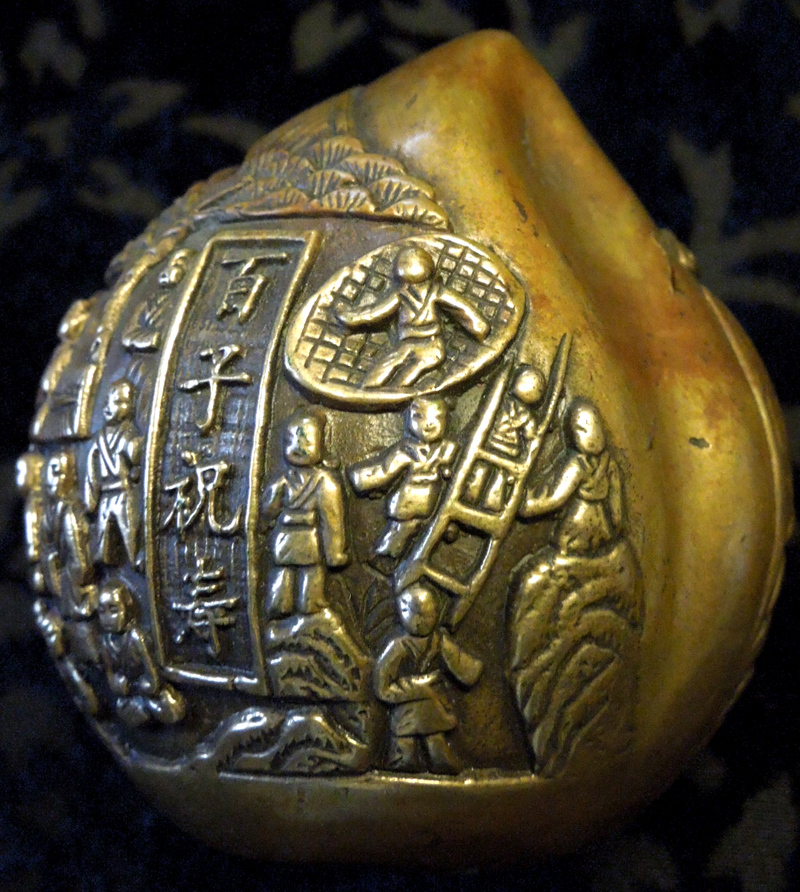 DG: I’d go further than that. I think it has erotic connotations – most all of these “peaches of immortality” have barely concealed erotic overtones. I think it’s a glyph for pollination. The men ascending the ladder seem to be trying to reach another man in some kind of container or basket. I think the contained man represents the branch in flower, and the other men are trying to pollinate him.
DG: I’d go further than that. I think it has erotic connotations – most all of these “peaches of immortality” have barely concealed erotic overtones. I think it’s a glyph for pollination. The men ascending the ladder seem to be trying to reach another man in some kind of container or basket. I think the contained man represents the branch in flower, and the other men are trying to pollinate him.
CC: You could see why the artist would be circumspect in depicting a matter that sensitive. I’d say that this proves beyond a shadow of a doubt that there is no coincidence here. The so-called peaches of immortality are nau’gsh. That means somehow, time-travel was involved. Through some unknown mechanism, knowledge of the “peach of immortality” was spread on ancient Earth.
DG: Wait. I thought we were posting this on a website in the 21st Century. The mechanism can’t be unknown.
CC: Well, what I mean is that we didn’t do it. Someone other than us told the Ancient Chinese about the nau’gsh. But who? That’s the mystery.
Bobert Crandon: That wraps up today’s spine-tingling journey. Join us again at some unspecified point in your future and my past when we investigate yet another mystery of the universe!



